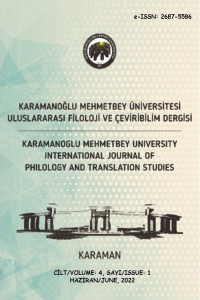Öz
In recent literary studies, fantasy literature has begun to be studied more and more frequently. The use of fantasy elements to deal with issues related to today's society also leads to a significant increase in the readership of this genre. Terry Pratchett, who is the writer of the Discworld series consisting of 41 novels, blends fantasy and satire skillfully in his novels. As the novel’s title gives some indication, Equal Rites, which was first published in 1987, is about equal rights in terms of gender. Talking about witches, magic, wizards and the Unseen University where women are not allowed to enter as a student or teacher, Pratchett combines the fantasy with serious topics about gender inequality. The story is set in Pratchett’s fantasy world -Discworld and the writer uses his other world to hold up a distorting mirror to our own. In this paper, how Pratchett deals with some serious gender-related issues such as male dominance in institutions, women’s struggles against the sexist point of view and stereotyped roles of men and women in his fantasy world are analysed via quotations from the novel. As a result of the analysis, it was found that the writer satirizes society by using elements of fantasy for all the inequalities that women face in different areas of life and offer various solutions to those inequalities.
Anahtar Kelimeler
Kaynakça
- Anderson, L. (2006). Which Witch is Which? A Feminist Analysis of Terry Pratchett’s Discworld Witches (Unpublished Master’s Thesis). Sweden: University of Halmstad.
- Beauvoir, S. D. (1989). The Second Sex. London: Vintage Books.
- Burrows, M. (2020). The Magic of Terry Pratchett. Great Britain: White Owl.
- Butler, A. (2001). The Pocket Essential: Terry Pratchett. Great Britain: Cox and Wyman.
- Butler, A. (2004). Theories of Humour. In Andrew M. Butler et.al., (Eds.), Terry Pratchett: Guilty of Literature (pp. 67-89). Baltimore: Old Earth Books.
- Broeder, L. (2007). Translating Humour: The Problems of Translating Terry Pratchett. (Unpublished Master’s thesis). Utrecht: Utrecht University.
- Croft, Janet Brennan. (2009). The Education of a Witch: Tiffany Aching, Hermione Granger, and Gendered Magic in Discworld and Potterworld. Mythlore Vol. 27, No. 3-4, pp. 129–42.
- Joule, C. (2021). By The Strength of Their Enemies: The Virtue of the Stereotypical Antagonist in Terry Pratchett’s Witches’ Novels. (Unpublished Doctoral Thesis). New Zealand: Victoria University of Wellington.
- Martin, P. (2009). A Guide to Fantasy Literature. USA: Crickhollow Books.
- Mathews, R. (2011). Fantasy: The Liberation of Imagination. USA: Routledge
- Moran, P. (2019). The Canons of Fantasy: Lands of High Adventure. United Kingdom: Cambridge University Press.
- Nuttall, A. (2018). Be a Witch, Be a Woman: Gendered Characterisation of Terry Pratchett’s Witches. In M. Rana. (Ed.), Terry Pratchett’s Narrative Worlds (pp.23-36). United Kingdom: MacMillian.
- Ozbay, E. (2021). Satire in Fantasy Literature: Terry Pratchett’s Discworld Series. (Unpublished Doctoral Thesis). Turkey: Ankara University.
- Pekşen, S. (2009). Bisexual Minds: A Study of the Novels of Angela Carter, Virginia Woolf, Marge Piercy and Ursula Le Guin from the Perspective of Écriture Féminine. Germany: VDM Verlag.
- Pratchett, T. (1987). Equal Rites: A Discworld Novel. London: Corgi Books.
- Rick, D.W. (2019). Rhetorics of the Fantastic: Re-Examining Fantasy As Action, Object, And Experience. (Unpublished Doctoral Thesis). Arizona: The University of Arizona.
- Rosen, R. M. (2012). Efficacy and Meaning in Ancient and Modern Political Satire: Aristophanes, Lenny Bruce, and Jon Stewart. Social Research, 79 (1), 1-32.
- Sinclair, Lian (2015) Magical Genders: The Gender(s) of Witches in the Historical Imagination of Terry Pratchett's Discworld. Mythlore Vol. 33, No. 2, pp.7-20.
- Weedon, C. (1987). Feminist Practice & Poststructuralist Theory. Oxford: Blackwell Publishers.
Öz
Son dönem edebiyat çalışmaları içinde fantezi edebiyatı giderek daha sık bir şekilde çalışılmaya başlanmıştır. Fantastik unsurların günümüz toplumunu ilgilendiren konuları ele almak için kullanılması bu türün okuyucu kitlesinde de ciddi bir artışa yol açmaktadır. 41 romandan oluşan Diskdünya serisinin yazarı Terry Pratchett, romanlarında fantastik ve hicvi ustalıkla harmanlamaktadır. İlk kez 1987 yılında basılan Eşit Haklar romanının adından da belli olduğu üzere, roman toplumsal cinsiyet açısından eşit hakları konu edinir. Pratchett, büyüler, cadılar, büyücüler ve sadece erkeklerin büyücü olarak yetiştirilmek üzere kabul edildiği Görünmez Üniversite gibi çeşitli unsurları kullanarak cinsiyet eşitsizliği ile ilgili konuları fantastik edebiyat ile birleştirir. Hikâye Pratchett'ın yarattığı fantastik dünya olan Diskdünya’da geçmektedir ve yazar gerçek dünyaya ait ciddi konuları ele alırken Diskdünya evrenini bu konuları okurlarına farklı bir bakış açısıyla yansıtan bir ayna olarak kullanır. Bu çalışmada, Pratchett’ın çeşitli kurumlardaki erkek egemenliği, kadınların cinsiyetçi bakış açısına karşı verdiği mücadeleler ve kadın ve erkeğin kalıplaşmış rolleri gibi bir takım ciddi sorunları kendi kurgu dünyasında nasıl ele aldığı ilgili romandan yapılan alıntılar aracılığıyla incelenmiştir. Yapılan analizler neticesinde, yazarın, kadınların hayatın farklı alanlarında karşılaştıkları tüm eşitsizlikler için fantastik unsurları kullanarak toplumu hicvettiği ve tespit ettiği bu eşitsizliklerin çözümü için çeşitli öneriler sunduğu tespit edilmiştir.
Anahtar Kelimeler
Kaynakça
- Anderson, L. (2006). Which Witch is Which? A Feminist Analysis of Terry Pratchett’s Discworld Witches (Unpublished Master’s Thesis). Sweden: University of Halmstad.
- Beauvoir, S. D. (1989). The Second Sex. London: Vintage Books.
- Burrows, M. (2020). The Magic of Terry Pratchett. Great Britain: White Owl.
- Butler, A. (2001). The Pocket Essential: Terry Pratchett. Great Britain: Cox and Wyman.
- Butler, A. (2004). Theories of Humour. In Andrew M. Butler et.al., (Eds.), Terry Pratchett: Guilty of Literature (pp. 67-89). Baltimore: Old Earth Books.
- Broeder, L. (2007). Translating Humour: The Problems of Translating Terry Pratchett. (Unpublished Master’s thesis). Utrecht: Utrecht University.
- Croft, Janet Brennan. (2009). The Education of a Witch: Tiffany Aching, Hermione Granger, and Gendered Magic in Discworld and Potterworld. Mythlore Vol. 27, No. 3-4, pp. 129–42.
- Joule, C. (2021). By The Strength of Their Enemies: The Virtue of the Stereotypical Antagonist in Terry Pratchett’s Witches’ Novels. (Unpublished Doctoral Thesis). New Zealand: Victoria University of Wellington.
- Martin, P. (2009). A Guide to Fantasy Literature. USA: Crickhollow Books.
- Mathews, R. (2011). Fantasy: The Liberation of Imagination. USA: Routledge
- Moran, P. (2019). The Canons of Fantasy: Lands of High Adventure. United Kingdom: Cambridge University Press.
- Nuttall, A. (2018). Be a Witch, Be a Woman: Gendered Characterisation of Terry Pratchett’s Witches. In M. Rana. (Ed.), Terry Pratchett’s Narrative Worlds (pp.23-36). United Kingdom: MacMillian.
- Ozbay, E. (2021). Satire in Fantasy Literature: Terry Pratchett’s Discworld Series. (Unpublished Doctoral Thesis). Turkey: Ankara University.
- Pekşen, S. (2009). Bisexual Minds: A Study of the Novels of Angela Carter, Virginia Woolf, Marge Piercy and Ursula Le Guin from the Perspective of Écriture Féminine. Germany: VDM Verlag.
- Pratchett, T. (1987). Equal Rites: A Discworld Novel. London: Corgi Books.
- Rick, D.W. (2019). Rhetorics of the Fantastic: Re-Examining Fantasy As Action, Object, And Experience. (Unpublished Doctoral Thesis). Arizona: The University of Arizona.
- Rosen, R. M. (2012). Efficacy and Meaning in Ancient and Modern Political Satire: Aristophanes, Lenny Bruce, and Jon Stewart. Social Research, 79 (1), 1-32.
- Sinclair, Lian (2015) Magical Genders: The Gender(s) of Witches in the Historical Imagination of Terry Pratchett's Discworld. Mythlore Vol. 33, No. 2, pp.7-20.
- Weedon, C. (1987). Feminist Practice & Poststructuralist Theory. Oxford: Blackwell Publishers.
Ayrıntılar
| Birincil Dil | İngilizce |
|---|---|
| Konular | Sanat ve Edebiyat |
| Bölüm | Araştırma Makaleleri |
| Yazarlar | |
| Yayımlanma Tarihi | 29 Haziran 2022 |
| Gönderilme Tarihi | 29 Nisan 2022 |
| Kabul Tarihi | 22 Haziran 2022 |
| Yayımlandığı Sayı | Yıl 2022 Cilt: 4 Sayı: 1 |
422x119
Articles published in this journal are licensed under Creative Commons Attribution 4.0 International license. This journal does not charge APCs or submission charges. Articles published in this journal are permanently free for everyone to read, download, copy, distribute, print, search and link to the full texts of these articles. |












